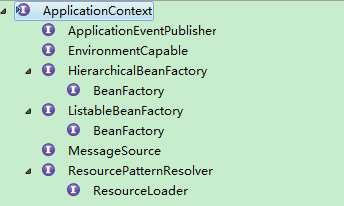はじめに:
使用springMvcは3年が経ちましたが、内装は非常に理解し、そしてServletConetxt ApplicationContextの大きな頭を参照してください、だけで、関連する知識の下で学び、学ぶために、これらの日を利用していないされていました。
1.ServletContext
まず、私たちがするServletContextについて話す、のServletContextはWebアプリケーションのグローバルな文脈で、グローバル変数、Webアプリケーション全体として理解することができ、すべてのメソッドは、プロジェクトがのServletContextを得ることができます。
ServletContextを言えば、それはすべてのWebプロジェクトをweb.xmlに来て、我々は最初のweb.xmlの構成の以下の部分を投稿しました:
<コンテキスト-PARAM>
<param-name>のcontextConfigLocation </ PARAM名>
<param-value>のクラスパス:applicationContext.xmlを</ PARAM値>
</コンテキスト-param>の
<コンテキスト-PARAM>
<param-name>のlog4jConfigLocation </ PARAM名>
<param-value>のクラスパス:log4j.properties </ PARAM値>
</コンテキスト-param>の
<聞き手>
<リスナークラス> org.springframework.web.util.IntrospectorCleanupListener </リスナクラス>
</リスナー>
<聞き手>
<リスナークラス> org.springframework.web.context.ContextLoaderListener </リスナクラス>
</リスナー>
<聞き手>
<リスナークラス> listener.SessionListener </リスナクラス>
</リスナー>
<フィルタ>
<フィルタ名> encodingFilter </フィルタ名>
<フィルタクラス> org.springframework.web.filter.CharacterEncodingFilter </フィルタクラス>
<init-param>の
<param-name>のエンコーディング</ PARAM名>
<param-value>のUTF-8 </ PARAM値>
</ initの-param>の
<init-param>の
<param-name>のforceEncoding </ PARAM名>
<param-value>の真</ PARAM値>
</ initの-param>の
</フィルタ>
<のfilter-mapping>
<フィルタ名> encodingFilter </フィルタ名>
<url-pattern> *。行う</のurl-pattern>
</フィルタマッピング>
<フィルタ>
<フィルタ名> sessionFilter </フィルタ名>
<フィルタクラス> web.filter.SessionFilter </フィルタクラス>
</フィルタ>
<のfilter-mapping>
<フィルタ名> sessionFilter </フィルタ名>
<url-pattern> *。行う</のurl-pattern>
</フィルタマッピング>
<servlet>
<servlet-name>のspringmvc </サーブレット名>
<servlet-class>のorg.springframework.web.servlet.DispatcherServlet </サーブレットクラス>
<load-on-startup> 1 </のload-on-startup>
</サーブレット>
<のservlet-mapping>
<servlet-name>のspringmvc </サーブレット名>
<url-pattern> *。行う</のurl-pattern>
</のservlet-mapping>
上記掲載のweb.xmlは、私たちの最初のWebプロジェクトを説明するロード順序が始まった構成の一部です:
Tomcatに例えば、その後、Tomcatを起動し、最初のweb.xmlファイルをロードします。
A)コンテナは、最初の<context-param>のweb.xmlの内容と<リスナー>タグの設定項目の設定を読み取られます。
B)その後のServletContextオブジェクトがインスタンス化され、そして<コンテキストPARAM>コンテンツ構成のServletContextは、変換キーに送信されます。
C)<リスナー>コンフィギュレーション・リスナーのインスタンスを作成し、リスニング開始。
D)リスナーcontextInitialized(ServletContextEvent引数)法のServletContext = ServletContextEvent.getServletContext()への後続の呼び出し。
この時点で、あなたがするServletContextコンテンツとコンテキストのparamの設定を変更することができますを介して取得することができ、その後、開始Tomcatが完全に終了していません。
E)フィルタ構成の後続のロード様々な種類;
F)最後にサーブレットをロードします。
最終的な結論は次のとおり負荷順序web.xml構成項目はコンテキストPARAM =>リスナー=>フィルタ=>サーブレット、設定項目であり、ロード順序を変更しないため、しかし設定項目の同じタイプの配列をロードすることができます、サーブレットは、負荷のload-on-startupの順序で指定することができます。
ServletContext属性は、すべてのサーブレットがサーブレットコンテキストを使用することができます。
2.ApplicationContext
最初のApplicationContextに導入、ApplicationContextのはたBeanFactory実装クラスの春です。

上のスクリーンショットのように継承ApplicationContextのインタフェース我々がここで参照する前に、ApplicationContextのは、それを生産する方法のweb.xmlです
<聞き手>
<リスナークラス> org.springframework.web.context.ContextLoaderListener </リスナクラス>
</リスナー>
 相続として残さ
相続として残さ
私たちは、初期化する方法を見て
公共WebApplicationContext initWebApplicationContext(のServletContextのServletContext){
もし(servletContext.getAttribute(WebApplicationContext.ROOT_WEB_APPLICATION_CONTEXT_ATTRIBUTE)!= NULL){
(新しいIllegalStateExceptionがスロー
+ - 「すでにルートアプリケーションコンテキストの存在があるため、コンテキストを初期化できません」
「あなたはweb.xmlに複数ContextLoaderの*の定義を持っているかどうかを確認!」);
}
ログロガー= LogFactory.getLog(ContextLoader.class)。
servletContext.log( "初期春のルートWebApplicationContext");
IF(logger.isInfoEnabled()){
logger.info( "ルートWebApplicationContext:初期化が開始");
}
長いのstartTime =にSystem.currentTimeMillis();
{試します
ローカルインスタンス変数に//ストアコンテキスト、ことを保証します
//それはのServletContextシャットダウン時に使用可能です。
IF(this.context ==ヌル){
this.context = createWebApplicationContext(のServletContext)。
}
IF(ConfigurableWebApplicationContext instanceofのthis.context){
ConfigurableWebApplicationContextのcwac =(ConfigurableWebApplicationContext)this.context。
(もし!cwac.isActive()){
//コンテキストは、まだリフレッシュされていない - >などのサービスを提供します
//など、親コンテキストを設定するアプリケーションコンテキストIDを設定します
IF(cwac.getParent()== NULL){
//コンテキストインスタンスは、明示的に親なしに注入しました - >
いずれの場合//、ルートWebアプリケーションコンテキストの親を決定します。
ApplicationContextの親= loadParentContext(のServletContext)。
cwac.setParent(親)。
}
configureAndRefreshWebApplicationContext(cwac、のServletContext)。
}
}
servletContext.setAttribute(C、この.context)。
クラスローダCCL =にThread.currentThread()getContextClassLoader()。
IF(CCL == ContextLoader.class.getClassLoader()){
currentContext = this.context。
}
それ以外(CCL!= null)の場合は{
currentContextPerThread.put(CCL、this.context)。
}
IF(logger.isDebugEnabled()){
logger.debug(「名前のサーブレットコンテキスト属性として公開されたルートWebApplicationContext [」+
WebApplicationContext.ROOT_WEB_APPLICATION_CONTEXT_ATTRIBUTE + "]");
}
IF(logger.isInfoEnabled()){
長い経過時間=にSystem.currentTimeMillis() - のstartTime。
logger.info( "ルートWebApplicationContext:で完了初期化" +経過時間+ "MS")。
}
this.context返します。
}
キャッチ(のRuntimeExceptionのEX){
logger.error( "コンテキストの初期化に失敗しました"、EX);
servletContext.setAttribute(WebApplicationContext.ROOT_WEB_APPLICATION_CONTEXT_ATTRIBUTE、EX);
EXを投げます。
}
キャッチ(誤差err){
logger.error(ERR、 "コンテキストの初期化に失敗しました");
servletContext.setAttribute(WebApplicationContext.ROOT_WEB_APPLICATION_CONTEXT_ATTRIBUTE、ERR)。
ERRを投げます。
}
}
太字部分のコードがWebApplicationContext WebApplicationContext.ROOT_WEB_APPLICATION_CONTEXT_ATTRIBUTEはServletContextへの鍵として保存話すことであるので、我々はでrequest.getSessionによると、取得する必要があるときは()。
getAttribute( "WebApplicationContext.ROOT_WEB_APPLICATION_CONTEXT_ATTRIBUTE")来获取WebApplicationContext。
だから、WebApplicationContextは、ApplicationContextの店のすべての春の豆のServletContextに依存し、
ApplicationContextのはのApplciationContext applicationContext.xmlを呼び出すことができますspringmvcしかし、一般的な存在applicationContext.xmlをspringmvc.xmlに加えて、当社の定期的なSpringmvcプロジェクトは、2つのプロファイルは、2のApplicationContextに対応させていただきます。
3.いくつかの方法で取得するのWebApplication
A)でrequest.getSession()。のgetServletContext()。のgetAttribute( "org.springframework.web.context.WebApplicationContext.ROOT")
b)のインタフェースを実装ApplicationContextAware
パブリックインターフェースApplicationContextAware {
空setApplicationContext(ApplicationContextのApplicationContextのは)BeansExceptionをスローします。
}
はじめに:
使用springMvcは3年が経ちましたが、内装は非常に理解し、そしてServletConetxt ApplicationContextの大きな頭を参照してください、だけで、関連する知識の下で学び、学ぶために、これらの日を利用していないされていました。
1.ServletContext
まず、私たちがするServletContextについて話す、のServletContextはWebアプリケーションのグローバルな文脈で、グローバル変数、Webアプリケーション全体として理解することができ、すべてのメソッドは、プロジェクトがのServletContextを得ることができます。
ServletContextを言えば、それはすべてのWebプロジェクトをweb.xmlに来て、我々は最初のweb.xmlの構成の以下の部分を投稿しました:
<コンテキスト-PARAM>
<param-name>のcontextConfigLocation </ PARAM名>
<param-value>のクラスパス:applicationContext.xmlを</ PARAM値>
</コンテキスト-param>の
<コンテキスト-PARAM>
<param-name>のlog4jConfigLocation </ PARAM名>
<param-value>のクラスパス:log4j.properties </ PARAM値>
</コンテキスト-param>の
<聞き手>
<リスナークラス> org.springframework.web.util.IntrospectorCleanupListener </リスナクラス>
</リスナー>
<聞き手>
<リスナークラス> org.springframework.web.context.ContextLoaderListener </リスナクラス>
</リスナー>
<聞き手>
<リスナークラス> listener.SessionListener </リスナクラス>
</リスナー>
<フィルタ>
<フィルタ名> encodingFilter </フィルタ名>
<フィルタクラス> org.springframework.web.filter.CharacterEncodingFilter </フィルタクラス>
<init-param>の
<param-name>のエンコーディング</ PARAM名>
<param-value>のUTF-8 </ PARAM値>
</ initの-param>の
<init-param>の
<param-name>のforceEncoding </ PARAM名>
<param-value>の真</ PARAM値>
</ initの-param>の
</フィルタ>
<のfilter-mapping>
<フィルタ名> encodingFilter </フィルタ名>
<url-pattern> *。行う</のurl-pattern>
</フィルタマッピング>
<フィルタ>
<フィルタ名> sessionFilter </フィルタ名>
<フィルタクラス> web.filter.SessionFilter </フィルタクラス>
</フィルタ>
<のfilter-mapping>
<フィルタ名> sessionFilter </フィルタ名>
<url-pattern> *。行う</のurl-pattern>
</フィルタマッピング>
<servlet>
<servlet-name>のspringmvc </サーブレット名>
<servlet-class>のorg.springframework.web.servlet.DispatcherServlet </サーブレットクラス>
<load-on-startup> 1 </のload-on-startup>
</サーブレット>
<のservlet-mapping>
<servlet-name>のspringmvc </サーブレット名>
<url-pattern> *。行う</のurl-pattern>
</のservlet-mapping>
上記掲載のweb.xmlは、私たちの最初のWebプロジェクトを説明するロード順序が始まった構成の一部です:
Tomcatに例えば、その後、Tomcatを起動し、最初のweb.xmlファイルをロードします。
A)コンテナは、最初の<context-param>のweb.xmlの内容と<リスナー>タグの設定項目の設定を読み取られます。
B)その後のServletContextオブジェクトがインスタンス化され、そして<コンテキストPARAM>コンテンツ構成のServletContextは、変換キーに送信されます。
C)<リスナー>コンフィギュレーション・リスナーのインスタンスを作成し、リスニング開始。
D)リスナーcontextInitialized(ServletContextEvent引数)法のServletContext = ServletContextEvent.getServletContext()への後続の呼び出し。
この時点で、あなたがするServletContextコンテンツとコンテキストのparamの設定を変更することができますを介して取得することができ、その後、開始Tomcatが完全に終了していません。
E)フィルタ構成の後続のロード様々な種類;
F)最後にサーブレットをロードします。
最終的な結論は次のとおり負荷順序web.xml構成項目はコンテキストPARAM =>リスナー=>フィルタ=>サーブレット、設定項目であり、ロード順序を変更しないため、しかし設定項目の同じタイプの配列をロードすることができます、サーブレットは、負荷のload-on-startupの順序で指定することができます。
ServletContext属性は、すべてのサーブレットがサーブレットコンテキストを使用することができます。
2.ApplicationContext
最初のApplicationContextに導入、ApplicationContextのはたBeanFactory実装クラスの春です。

上のスクリーンショットのように継承ApplicationContextのインタフェース我々がここで参照する前に、ApplicationContextのは、それを生産する方法のweb.xmlです
<聞き手>
<リスナークラス> org.springframework.web.context.ContextLoaderListener </リスナクラス>
</リスナー>
 相続として残さ
相続として残さ
私たちは、初期化する方法を見て
公共WebApplicationContext initWebApplicationContext(のServletContextのServletContext){
if (servletContext.getAttribute(WebApplicationContext.ROOT_WEB_APPLICATION_CONTEXT_ATTRIBUTE) != null) {
throw new IllegalStateException(
"Cannot initialize context because there is already a root application context present - " +
"check whether you have multiple ContextLoader* definitions in your web.xml!");
}
Log logger = LogFactory.getLog(ContextLoader.class);
servletContext.log("Initializing Spring root WebApplicationContext");
if (logger.isInfoEnabled()) {
logger.info("Root WebApplicationContext: initialization started");
}
long startTime = System.currentTimeMillis();
try {
// Store context in local instance variable, to guarantee that
// it is available on ServletContext shutdown.
if (this.context == null) {
this.context = createWebApplicationContext(servletContext);
}
if (this.context instanceof ConfigurableWebApplicationContext) {
ConfigurableWebApplicationContext cwac = (ConfigurableWebApplicationContext) this.context;
if (!cwac.isActive()) {
// The context has not yet been refreshed -> provide services such as
// setting the parent context, setting the application context id, etc
if (cwac.getParent() == null) {
// The context instance was injected without an explicit parent ->
// determine parent for root web application context, if any.
ApplicationContext parent = loadParentContext(servletContext);
cwac.setParent(parent);
}
configureAndRefreshWebApplicationContext(cwac, servletContext);
}
}
servletContext.setAttribute(c, this.context);
ClassLoader ccl = Thread.currentThread().getContextClassLoader();
if (ccl == ContextLoader.class.getClassLoader()) {
currentContext = this.context;
}
else if (ccl != null) {
currentContextPerThread.put(ccl, this.context);
}
if (logger.isDebugEnabled()) {
logger.debug("Published root WebApplicationContext as ServletContext attribute with name [" +
WebApplicationContext.ROOT_WEB_APPLICATION_CONTEXT_ATTRIBUTE + "]");
}
if (logger.isInfoEnabled()) {
long elapsedTime = System.currentTimeMillis() - startTime;
logger.info("Root WebApplicationContext: initialization completed in " + elapsedTime + " ms");
}
return this.context;
}
catch (RuntimeException ex) {
logger.error("Context initialization failed", ex);
servletContext.setAttribute(WebApplicationContext.ROOT_WEB_APPLICATION_CONTEXT_ATTRIBUTE, ex);
throw ex;
}
catch (Error err) {
logger.error("Context initialization failed", err);
servletContext.setAttribute(WebApplicationContext.ROOT_WEB_APPLICATION_CONTEXT_ATTRIBUTE, err);
throw err;
}
}
代码中加粗的部分就是讲WebApplicationContext以WebApplicationContext.ROOT_WEB_APPLICATION_CONTEXT_ATTRIBUTE为key保存到ServletContext中,所以我们在需要获取时,可以根据request.getSession().
getAttribute("WebApplicationContext.ROOT_WEB_APPLICATION_CONTEXT_ATTRIBUTE")来获取WebApplicationContext.
所以WebApplicationContext依赖于ServletContext,ApplicationContext存储了Spring中所有的Bean,
但是我们常规的Springmvc项目一般除了applicationContext.xml之外还有springmvc.xml,两个配置文件会对应两个ApplicationContext,springmvc的ApplicationContext中可以调用applicationContext.xml的ApplciationContext。
3.获取WebApplication的几种方式
a)request.getSession().getServletContext().getAttribute("org.springframework.web.context.WebApplicationContext.ROOT")
b)实现ApplicationContextAware接口
public interface ApplicationContextAware {
空setApplicationContext(ApplicationContextのApplicationContextのは)BeansExceptionをスローします。
}

